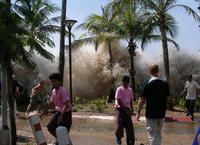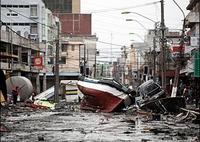-
U.S. intervention hinders disaster recovery, says reinsurance giant
Lloyd’s of London, the largest reinsurer of U.S. risk, said the federal government’s intervention in the insurance market could hinder recovery efforts following natural disasters; “We don’t believe that the U.S. has the balance between industry and government intervention right, you have government intervention in federal and state level, it demonstrates this is not a sustainable way to proceed,” said Lloyds general counsel
-
-
Disaster scams on the rise
In the immediate aftermath of natural disasters, fraudsters have increasingly rushed in to take advantage of the outpouring of charitable donations; speaking on a panel at an international symposium on organized fraud in Australia, the Department of Justice’s deputy chief for strategy and policy in the Fraud Section of the Criminal Division, said scammers had websites for fake charities in place before predicted disasters had even hit
-
-
Connecticut town considers charging centers for power outages
Following Hurricane Irene which left thousands without power up and down the East Coast, a town in Connecticut is considering building several charging stations for residents to power up their hand held electronics during a natural disaster or prolonged power outage
-
-
Georgia shows app that prepares state residents, guides them to safety
New Ready Georgia mobile app uses geo-location to deliver alerts, create emergency plans, and show shelter locations; from up-to-the-minute weather and hazard alerts based on a user’
‘s location, to customizable emergency preparedness checklists, the app combines a set of features not previously available in one mobile application -
-
Saving victims trapped under concrete
New tool allow first responders to reach those trapped beneath concrete more quickly; the tool generates a high-energy jolt to create a contained hole in the concrete; a series of these holes allows the creation of an area large enough to deliver vital supplies such as food, water, and medicine to victims before first responders are able to get victims to safety.
-
-
Better understanding of how tsunamis work

One of the obstacles to understanding how tsunamis work is the notion that it is the first wave that is the worst; researchers show that this is not the case, and that the second, third, or even fourth wave are often the most destructive
-
-
Tsunami-predicting software to help protect coastal communities

New software has been developed to help protect vulnerable coastal communities from the destruction of a tsunami; the mathematical model has created significant interest in the wake of the 2011 earthquake and tsunami in Japan six months ago
-
-
Japan nuke accident halves nuclear power growth
The nuclear meltdown at the Fukushima Daiichi plant appears to have caused nations around the world to reconsider nuclear projects; following the accident, demand for future nuclear projects has been halved
-
-
Earth's largest environmental catastrophe: 250 million year anniversary
The eruption of giant masses of magma in Siberia 250 million years ago led to the Permo-Triassic mass extinction when more than 90 percent of all species became extinct
-
-
Building codes may underestimate multiple hazard risks
Current building codes consider natural hazards individually — if earthquakes rank as the top threat in a particular area, local codes require buildings to withstand a specified seismic load; if hurricanes or tornadoes are the chief hazard, homes and buildings must be designed to resist loads up to an established maximum wind speed; engineers say that building codes should address multiple hazard scenarios
-
-
Texas drought forces military to change training

A particularly severe drought in Texas has forced the military to change the way it trains its soldiers due to the risk of starting fires; law enforcement agencies would benefit from taking note of additional safety measures put into place
-
-
Natural disasters stretch NGO relief teams to the limit
The recent spate of natural disaster has stretched the nation’s third largest NGO disaster relief program to the limit; in the last several months, the Southern Baptist Convention (SBC) has sent more than 3,300 volunteers to five natural disasters across the United States
-
-
Severe drought in Georgia, 150 counties declared disaster areas
A severe drought and excessive heat has forced the U.S. Department of Agriculture to declare 150 counties in Georgia as primary natural disaster areas; the drought began on 15 April and has caused farmers to lose more than 30 percent of their pasture, grain crops, cotton, peanuts, tobacco, and forage crops
-
-
Republicans agree to move quickly on emergency FEMA funds
Top Republican lawmakers say they will move quickly to pass President Obama’s request for emergency aid for victims of recent natural disasters like Hurricane Irene
-
-
Using breath and sweat to detect trapped disaster victims
Molecules in breath, sweat, and skin have been used by researchers to detect humans in a simulation of a collapsed building, offering the prospect of portable sensors for use in real-life situations, such as the devastating aftermath of devastating disasters
-
- All
- Regional
- Water
- Biometrics
- Borders/Immig
- Business
- Cybersecurity
- Detection
- Disasters
- Government
- Infrastructure
- International
- Public health
- Public Safety
- Communication interoperabillity
- Emergency services
- Emergency medical services
- Fire
- First response
- IEDs
- Law Enforcement
- Law Enforcement Technology
- Military technology
- Nonlethal weapons
- Nuclear weapons
- Personal protection equipment
- Police
- Notification /alert systems
- Situational awareness
- Weapons systems
- Sci-Tech
- Sector Reports
- Surveillance
- Transportation
Advertising & Marketing: advertise@newswirepubs.com
Editorial: editor@newswirepubs.com
General: info@newswirepubs.com
2010-2011 © News Wire Publications, LLC News Wire Publications, LLC
220 Old Country Road | Suite 200 | Mineola | New York | 11501
Permissions and Policies
Editorial: editor@newswirepubs.com
General: info@newswirepubs.com
2010-2011 © News Wire Publications, LLC News Wire Publications, LLC
220 Old Country Road | Suite 200 | Mineola | New York | 11501
Permissions and Policies
